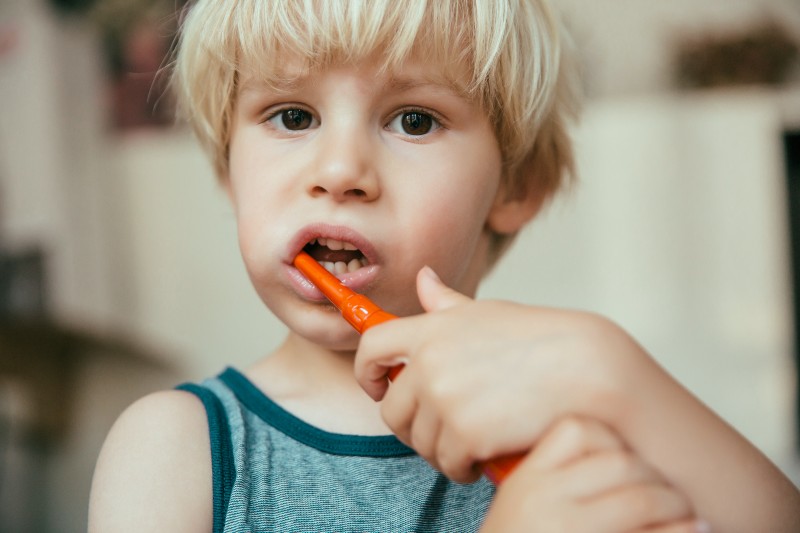
How to Choose the Ideal Toothbrush for Children

Choosing the right toothbrush for children is essential to ensure good oral hygiene from an early age. An appropriate toothbrush not only facilitates teeth cleaning but also helps instill good oral health habits that will last a lifetime.
In this article, we will explore the key aspects to consider when selecting the ideal toothbrush for the little ones.
Importance of a Good Toothbrush for Children
Children’s dental health is an essential part of their overall well-being. A suitable toothbrush can prevent problems such as cavities, gum disease, and bad breath. Moreover, a good toothbrush facilitates the removal of bacterial plaque and food debris, ensuring that teeth and gums remain healthy. Teaching children to brush correctly from a young age is crucial to avoid dental complications in the future.
What Features Should a Toothbrush for Children Have?
When choosing a toothbrush for children, it is important to consider several features that ensure effective and comfortable cleaning. The following are the most important aspects:
Size and Shape of the Toothbrush
The size of the toothbrush should be suitable for the child’s mouth. Smaller toothbrushes are easier to handle and allow reaching all areas of the mouth. The shape of the head should also be rounded to avoid damaging sensitive gums and teeth.
Soft Bristles and Materials
The bristles of the toothbrush should be soft to protect the children’s gums and dental enamel. Toothbrushes with hard bristles can cause abrasion and damage to the gums. Additionally, it is important that the material of the toothbrush is safe and non-toxic, ensuring there are no risks to the child’s health.
Ergonomic Handle
The handle of the toothbrush should be ergonomic and easy to grip. A good grip allows children to brush their teeth more effectively and comfortably. Some toothbrushes have non-slip handles or are specifically designed for small children’s hands, making them easier to use.
Factors to Consider According to the Child’s Age
The child’s age is a crucial factor when choosing a toothbrush. The requirements of a baby are not the same as those of a school-age child.
Toothbrushes for Babies
For babies, it is essential to use a toothbrush with ultra-soft bristles and a very small head. There are toothbrushes that can be placed on the parent’s finger to facilitate cleaning the first teeth. It is important to start cleaning the gums even before the teeth appear to get the baby used to the routine.
Toothbrushes for Young Children (2-5 years old)
As children grow and develop more teeth, they need a toothbrush with a slightly larger head but still with soft bristles. Toothbrushes with ergonomic and non-slip handles are ideal for this stage, as children begin to learn to brush themselves.
Toothbrushes for Older Children (6 years and older)
For older children, a toothbrush with a larger head and soft bristles is still important. At this stage, children can benefit from electric toothbrushes that facilitate more effective brushing. They can also use toothbrushes with timers to ensure they brush for the adequate time.
How Often Should the Toothbrush Be Changed?
Changing the toothbrush regularly is essential to maintain good oral hygiene. Dentists recommend changing the toothbrush every three months or earlier if the bristles are worn out. A worn-out toothbrush does not clean effectively and can harbor bacteria that are harmful to the child’s oral health. Additionally, it is important to replace the toothbrush after an illness to prevent reinfection and ensure the child uses a clean and effective toothbrush.
Tips for Making Brushing a Fun Activity
Instilling good brushing habits can be challenging, but turning the routine into a fun activity can make a big difference. Here are some tips to achieve this:
Toothbrushes with Characters and Colors
Choosing toothbrushes with the child’s favorite characters or vibrant colors can make the brushing activity more appealing. Many manufacturers offer toothbrushes with cartoon or superhero themes that children love.
Games and Songs
Incorporating games and songs during brushing can make the time pass faster and more fun. There are apps and videos that guide children through the brushing routine with music and animated characters.
Rewards and Progress Charts
Establishing a reward system for brushing correctly can motivate children. Progress charts where they can mark the days they have brushed can be a useful tool to encourage consistency and habit.
Choosing the ideal toothbrush for children is crucial to establishing a solid foundation of good oral hygiene habits. Considering aspects such as the size and shape of the toothbrush, the softness of the bristles, and the ergonomics of the handle can make a big difference in the effectiveness of brushing. Deciding between a manual and an electric toothbrush depends on the child’s needs and preferences, as well as their age.
Additionally, changing the toothbrush regularly and making brushing a fun activity are essential practices to maintain children’s dental health. By following these tips, parents can ensure their children develop an effective brushing routine and enjoy optimal oral health from an early ag
Share



